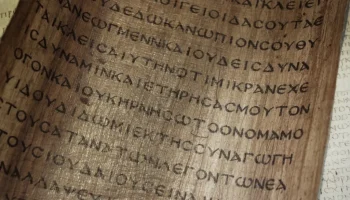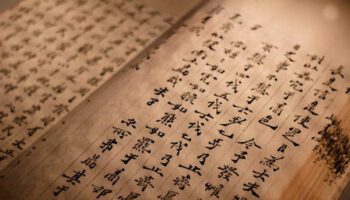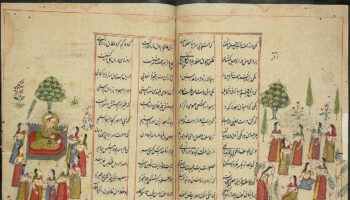The Renaissance is generally dated from fourteenth-century Italy to the middle of the seventeenth century. The term renaissance literally means rebirth, and the writers of the Renaissance presented it as an era of new beginnings. Christopher Columbus traveled across the Atlantic Ocean from Spain and landed in the Americas. In astronomy, Nicolaus Copernicus and Galileo Galilei determined that the Earth revolves around the Sun, which altered Europeans’ understanding of the cosmos. Such discoveries called for a new era of curiosity and creativity. Like great medieval thinkers before them, Renaissance writers engaged with and imitated works from antiquity, specifically works from the classical Greek and Roman eras. Writers believed that ancient texts could give new life to their own work and that the study of classical texts could help their communities become more broadly educated and more capable of diverse and rational thought. They advocated a broad range of learning reflective of antiquity’s influence, including the fields of literature, philosophy, rhetoric, and history.
A medieval writer credited with beginning the Renaissance, the Italian Francesco Petrarch is best known for his collection of love poems celebrating Laura, Il Canzoniere (or Song Book, c. 1360), written in contemporary Italian vernacular rather than Latin.
The poems in this collection recount the speaker’s undying love for Laura but also his agony because he cannot have her. In sonnet 269, he invokes several figures from Greek and Roman mythology to capture the vastness of his love. He notes that “Jove exults in Venus’ prospering. / Love is in all the water, earth, and air, / And love possesses every living thing,” before bemoaning his own lack of love (lines 6–8). Petrarch draws on these classical images to demonstrate his immense suffering without Laura, which he considers in sonnet 126:
Who knows her not can never realize
How beauty may the heart of man beguile,
And who looks not upon my Laura’s eyes
Knows not how love can kill and otherwhile
May heal us; let him hear how soft she sighs
And gently speaks, oh, let him see her smile!
(lines 9–14)
Petrarch distills the paradoxical concept of the pain of love in this passage. Along with Petrarch, Dante (The Divine Comedy) and Boccaccio (The Decameron) wrote their own masterpieces, making fourteenth-century Italy one of the most scintillating periods in all of world literature.
Nearly 200 years after Petrarch’s work, Baldesar Castiglione, in The Book of the Courtier, describes the customs and decorum of courtiers, those who regularly attend the court of a king or other member of royalty. Castiglione’s book records fictional conversations among a group of courtiers in which they comment on such subjects as appearance, speech, physical ability, and the arts. Many of the recommendations proffered in the book are superficial yet practical, such as that a courtier should take care with his physical appearance and dress. The book also addresses acts of physical bravery, such as fighting in battle. Castiglione recommends that, if possible, the courtier should perform his actions to win the admiration of his social betters, and he should do this in as small a company as possible and in the sight of all the noblest and most respected men in the army, and especially in the presence of and, if possible, before the very eyes of his king or the prince he is serving; for it is well indeed to make all one can of the things well done.
Although the true worth of heroic action rests in the action itself, the courtier’s need for recognition demonstrates the public nature of this role. The effective courtier seeks respect in the court, which depends on his social betters appreciating his contributions.
Soon after The Book of the Courtier, Niccolò Machiavelli wrote The Prince, a political discourse on gaining and maintaining power. Like The Book of the Courtier, The Prince advises readers on court life but focuses instead on the strategies necessary to reign. This work advocates force when necessary to meet one’s ends, to “know well how to imitate beasts as well as employing properly human means” (61; chapter 18). Furthermore, while Machiavelli asserts that “every ruler should want to be thought merciful,” he also advises strategic deployments of cruelty:
If a ruler can keep his subjects united and loyal, he should not worry about incurring a reputation for cruelty; for by punishing a very few he will really be more merciful than those who over-indulgently permit disorders to develop, with resultant killings and plunderings. For the latter usually harm a whole community, whereas the executions ordered by a ruler harm only specific individuals.
(58; chapter 17)
Machiavelli seeks to establish and maintain an orderly, efficient society under the effective control of a prince. The means may be manipulative and sometimes brutal, but Machiavelli believes that the achievement of the goals justifies the ways in which one attains them.
Frenchman Michel de Montaigne developed a new approach to nonfiction writing with his Essays. Collected in three volumes and published between 1580 and 1595, Montaigne’s essays allow readers to follow him on self-reflective journeys concerning such topics as the imagination, friendship, repentance, and education. His essays adopt a personal tone, reflecting his observations and experiences, as he affirms in the preface:
Had it been my purpose to seek the world’s favour, I should have put on finer clothes, and have presented myself in a studied attitude. But I want to appear in my simple, natural, and everyday dress, without stain or artifice; for it is myself that I portray.
Montaigne’s essays cite a range of sources from the Greco-Roman classical era, including those of Cicero, Seneca, and Quintilian, as well as more contemporary sources, such as Castiglione’s The Book of the Courtier. Despite his erudition, he adopts a humble persona, as evidenced in “On Books,” when he writes, “I have no doubt that I often speak of things which are better treated by the masters of the craft, and with more truth. This is simply a trial of my natural faculties, and not of my acquired ones,” after which he quotes Catullus, Horace, and Virgil. Renaissance authors placed great value on classical learning, and Montaigne’s essays capture the Renaissance spirit of intellectual curiosity.
One of the great masterworks of the Renaissance and the first European novel, Miguel de Cervantes’s Don Quixote, published in two volumes
in 1605 and 1615, satirizes chivalric romances such as Sir Gawain and the Green Knight and Le Morte D’Arthur, which tell of heroic knights errant undertaking quests in pursuit of worthy causes. Don Quixote, so obsessed with romances that he believes he is a knight, begins his quest to reawaken the chivalric spirit. Throughout his journey, he consistently misunderstands the world, and his absolute belief in his own interpretations sparks much of the novel’s comedy and pathos. His romantic, misguided view of the world is offset by that of his “squire,” the farmer Sancho Panza, whose witty reactions ironically comment on Don Quixote’s misinterpretations. In one of the novel’s most memorable passages, the men see a group of windmills, which Don Quixote believes to be giants. Sancho explains his error:
“Those over there are not giants but windmills, and those things that seem to be arms are their sails, which when they are whirled around by the wind turn the millstone.”
“It is clear,” replied Don Quixote, “that you are not experienced in adventures. Those are giants, and if you are afraid, turn aside and pray whilst I enter into the fierce and unequal battle with them.”
(98; part 1, chapter 8)
After Don Quixote races to battle, his lance is caught in a windmill’s arms, throwing him and his horse to the ground. Throughout the book, Don Quixote’s fanciful beliefs lead him both to express buoyant optimism regarding his quest and to suffer repeated failures. Apart from its satiric elements, Don Quixote stands as a classic of Renaissance literature for the inventive metatextual strategies used in its sequel. Published ten years after the popular first part of the book, the second part begins with Don Quixote’s discovery that his adventures have been published in the book Don Quixote: “He could not convince himself that such a history could exist, for the blood of the enemies he had slain was hardly dry on the blade of his sword, yet they were already saying that his high deeds of chivalry were in print” (544; part 2, chapter 3). By referring to the novel Don Quixote in its continuation, Cervantes challenges the boundaries between fiction and reality. As Renaissance ideals and literary art spread throughout Europe, artists of each nation jointly looked to the past and to the future in creating new ways to express the human condition.



